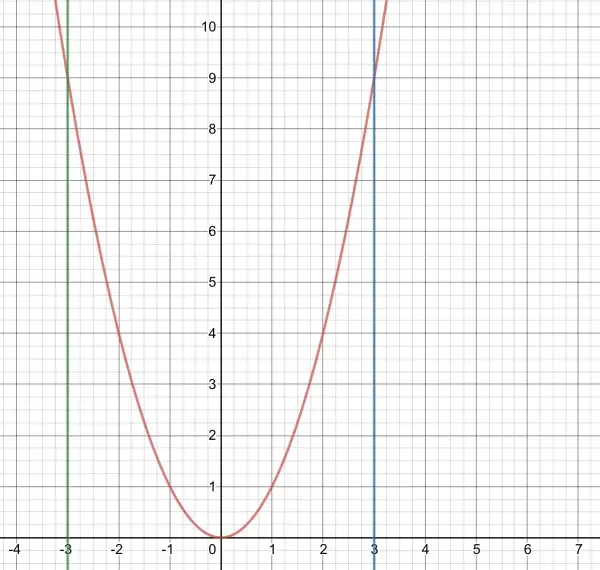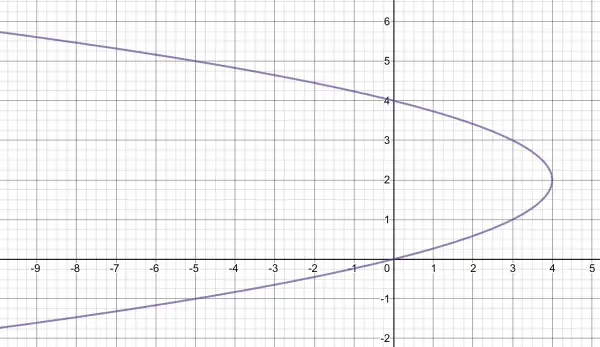b) I think the answer is 108π cubic units.
There are three ways I can think of that confirm this result, so that you can see the one you prefer. Briefly these methods are:
(1) The line x=3 is 6 units from the axis x=-3, and the lines meet the verticals at y=9. So if x=3 is rotated around x=-3, it will produce a cylinder of radius 6 and height 9, volume=9(π6²)=324π cubic units. Now if we find the volume of the parabola rotated around x=-3, using integration, and subtract it from 324π we get the volume of the region between the parabola and the given lines.
(2) Using a combination of washer and disk methods we can calculate the volume directly using integration with respect to y. This method needs a little thought.
(3) We can use the thin cylinder method for developing an integral with respect to x. The method requires a little thought.
(1) Take a point P on the parabola x≥0, this point is a distance x+3 from the line x=-3. Now consider a complementary point Q at -x. This point is a distance 3-x between the other arm of the parabola and the line x=-3.

The line QP forms the width of a thin washer of thickness dy, with outer radius x+3 and inner radius 3-x. The volume of the washer is:
π((x+3)²-(x-3)²)dy=12πxdy. So the volume of the parabola rotated around x=-3 is 12π∫xdy=12π∫√ydy[0,9]=12π[⅔y^(3/2)]⁹₀=8π(27)=216π. So “scooping out” this volume from 324π we get 108π cubic units.
(2) Here we have a washer thickness dy created by the right arm of the parabola and the line x=3. Outer radius is fixed at 6 (the distance between x=-3 and x=3). The inner radius is x+3 where x≥0. So the volume of the washer is π(36-(x+3)²)dy. Now we turn to the left arm of the parabola and consider a disk thickness dy and radius 3-x. Its volume is π(3-x)²dy when it’s rotated around x=-3. Adding together the volumes of the washer and disk:
π(36-(x+3)²)dy+π(3-x)²dy=π(36-12x)dy.
The integral becomes:
12π∫(3-x)dy=12π∫(3-√y)dy[0,9]=12π[3y-⅔y^(3/2)]⁹₀=12π(27-18)=108π.
(3) Again we consider the two arms of the parabola separately, starting with the right arm (x≥0). The radius of a thin cylinder height y and thickness dx has a volume around x=-3 of 2π(x+3)ydx. This the volume of a rectangle length 2π(x+3) the “opened out” lamina of the cylinder) and height y. At the left arm of the parabola has a corresponding cylinder of volume 2π(3-x)ydx. This time the combined volumes are:
2π(x+3)ydx+2π(3-x)ydx=12πydx=12πx²dx.
The limits of integration only have to be [0,3] because we are considering the combined volumes of two cylinders.
Volume=∫12πx²dx[0,3]=108π.
(d) and (e) use the same graph x=4y-y² which is a parabola lying on its side with vertex (4,2) pointing to the right. A picture helps.
To find the vertex we rewrite the equation:
x=4 - 4+4y-y²=4-(y-2)². This has a maximum x=4 when y=2, so the vertex must be (4,2). It looks odd only because the roles of x and y are reversed from normal.
d) 
The region of interest is the “bulge” protruding from the y-axis and the parabola intersects the y-axis at (0,0) and (0,4). As this part of the parabola is rotated around the y-axis the radius is x. So let’s consider a disk thickness dy and radius x. The volume of the disk is πx²dy and we integrate this wrt y between 0 and 4. (Sum of all disks.)
π∫x²dy=π∫(4y-y²)²dy[0,4]=π∫(16y²-8y³+y⁴)dy[0,4].
This gives us π[16y³/3-2y⁴+y⁵/5]⁴₀=π(1024/3-512+1024/5)=512π/15 cu units.
e) When the parabola is rotated around the x-axis the situation is quite different. This time the radius will be the y value but there’s a gap between the lower arm of the parabola and the x-axis. So we end up with thin washers, thickness dx. Since x=4-(y-2)², (y-2)²=4-x, and y-2=±√(4-x).
What does this mean? The outer radius of the washer is 2+√(4-x) and the inner radius 2-√(4-x). The volume of the washer is π((2+√(4-x))²-(2-√(4-x))²)dx.
This is the difference of two squares so:
Volume=π∫8√(4-x)dx[0,4].
Let u²=4-x, -2udu=dx. When x=0, u=2 and when x=4, u=0.
Volume=8π∫-2u²du[2,0]=16π∫u²du[0,2]=16π[u³/3]²₀=128π/3 cu units.